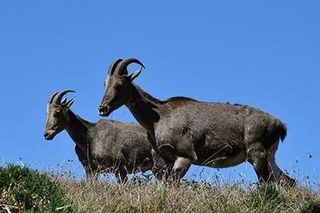
Invasive, Exotic Tree Species Are Threatening the Animals of the Western Ghats
Colonial attempts to re-engineer the natural biome have resulted in a dwindling food supply for indigenous animals years later.

Invasive, non-native species of trees — acacias, pines, and eucalyptus — are erasing biodiversity across the Western Ghats in the Nilgiris, Palani Hills, and Anamalai, and pushing endemic species of plants, birds, amphibians, and mammals closer to extinction, a new study notes. The trees were introduced by the British in order to convert grasslands and shola forests into a more aesthetically pleasing and commercially profitable landscape.
The International Union for Conservation of Nature, commonly known as IUCN, defines invasive alien species as those that are introduced, either accidentally or intentionally, in areas outside their natural geographic range and then establish themselves in natural or semi-natural ecosystems — often beginning to threaten native biodiversity.
In the century between the 1820s and the 1930s, British colonizers introduced to the Western Ghats more than 40 new, invasive, and exotic trees, without any research or understanding of the different types of plants, ecosystems, or soils prevalent in the region. By independence, the Indian economy had become reliant on the exotic species, and their cultivation was encouraged. But in the 1990s, as the Indian economy grew stronger and awareness grew of the pitfalls of converting natural ecosystems into non-native plantations, forest departments stopped harvesting these species. Since then, their growth has been unchecked and purely invasive.
Most of these exotic tree species prevent the growth of local flora by making the soil acidic and altering the soil’s nutrient cycle. Further, the invasive species also compete with native plants for space and resources. Not only does this affect herbivores, who depend on the local florafor food, but also, by extension, affects the carnivores of the region.
Among the animals most threatened by the invasive tree species is the Nilgiri Pipit bird, which thrives in grasslands that are being taken over. The gaurs face a similar threat, as their habitat loss leads them to venture into human territories, prompting conflicts with humans. The Nilgiri Tahr is yet another species venturing increasingly into towns in order to forage for food, as its food sources shrink with the spread of the trees.
Related on The Swaddle:
Habitat Loss, Climate Change Endangers 3 Wildcat Species Unique to South Asia
Published in the Journal of Environmental Management, the study on invasive, exotic species pushing endemic species to the brink of extinction was conducted by researchers from the Indian Institute of Science Education and Research in Andhra Pradesh and the Ashoka Trust for Research in Ecology and the Environment, Karnataka.
The researchers also highlighted the lack of attention given to the menace of invasive species in the Western Ghats. “In India, [these grasslands] have even been classified as wastelands in forest management plans since they are unlikely to generate revenue, contrary to the timber (even if exotic) found in forests. … Grasslands are not wastelands. Though they are not being put to use, we are benefiting in other ways — such as serving as pasture. In the Sholas, they are responsible for hydrological recharge,” the researchers said in a statement.
In January 2019, a petition before the Madras High Court, highlighting the damage caused by exotic plant species to local flora and fauna in the Western Ghats, noted that 65% to 75% of the region’s plants were invasive. “The standing trees on the first blush might give the impression of a healthy forest, but they actually deliver the sad story of aging and dying. The weaker they become, the greater the spreading of invasive species. The crisis is impending and looming, notwithstanding the efforts put forth by the State till now,” the judgement noted.
Recognizing the pressing need to remedy the situation, the High Court also constituted an expert committee to suggest measures to remove the exotic species and rehabilitate the forests. “The Shola vegetation has become relict in Ooty Nilgiris and may vanish soon as a result of exotics and tea plantations,” the subsequent report by the expert committee in September 2019 said. It recommended mass mapping of invasive species in each forest division of the Nilgiris, followed by their removal, for “ecological restoration of weed-free landscapes.”
Related on The Swaddle:
India’s Pollution Regulators Are Ineffective Due to a Lack of Expertise, Resources: Report
However, while acknowledging the damage the invasive species have caused to the local biodiversity, experts are concerned mass removal could lead to further ecological issues; instead, they suggest, these species should be phased out with different strategies, alongside being replaced with supplementary planting of native grasses.
Moreover, wattle, one of the most invasive species in the Western Ghats, supplies firewood to the locals for cooking and heating, and so, “we [will] need buffers of wattle to satisfy the prevailing high demand of firewood,” Farshid Ahrestani, Ph.D., a wildlife and quantitative ecologist, wrote in Conservation India.
The present study recognizes these dilemmas and its researchers suggest identifying grassland restoration sites using satellite images before embarking on careful removal of young and isolated exotic trees — instead of removing dense stands of mature exotic trees.
“For [some] invasive species … removing mature trees is often ineffective. An approach that targets the removal of young exotic trees would be more effective. Similarly, restoring grasslands where isolated but mature trees exist in grassland patches could be an easy way to restrict further dispersal,” the study notes.
Devrupa Rakshit is an Associate Editor at The Swaddle. She is a lawyer by education, a poet by accident, a painter by shaukh, and autistic by birth. You can find her on Instagram @devruparakshit.
Related


We Will Soon Have Sentient Sex Robots. Will They Be Able To Consent?
